Application Notes (Rel. 3.0)
|
SOT1, SOT2 Types |
High Performances S-D Audio DACs as Crystal's 43XX Serie have the following characteristics:
A Differential Output Stage as shown in Fig.1;
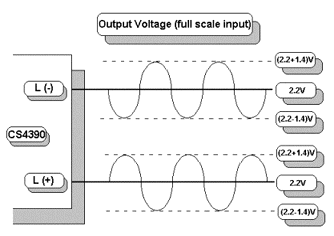
A Noise Spectrum due to Noise Shaping circuitry as shown in Fig. 2.
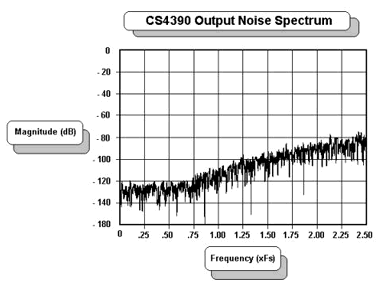
Standard remedies use op-amps both for the differential to single-ended conversion (if requested) and filtering process.
Solid State Op-Amps have unsurpassed electrical performances but, unfortunately, many audiophiles refuse their use because sonic performances can be unsatisfactory. On the other side, Op-Amps based on Vacuum Tubes Technology are "strange animals" with poor electrical performances.
What's the best solution?
A signal audio transformer is a relatively simple object with excellent potentialities in this arena because imperfections of real-world transformers (as leakage inductances) can be used for inherent low-pass filtering.
In this manner output circuit remains simple, Fig. 3, and performances are very good.
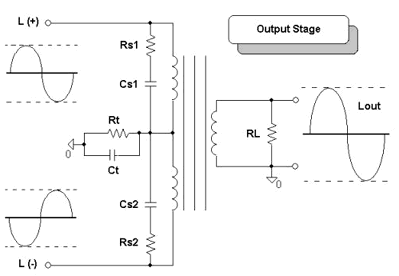
SOT1 type with a leakage inductance of 15mH is optimised for 1st generation of DACs (Sampling Frequency up to 48kHz).
SOT2 type with a leakage inductance less than 10mH is optimised for 2nd generation of DACs ( 96..192kHz Sampling Frequency Range).
Although designed around IC DACs with voltage output stage, SOT1 and SOT2 type can be effectively used also with Laddered/Current-Switched DACs as Burr-Brown's PCM Series.
In this context the mainstream approach is to use a current to voltage converter build around an high performance solid state op-amp.

Variants based on this schematic make use of Discrete Solid State Op-Amp or simple Current to Voltage Vacuum Tube Converters. For example the following figure shows a converter based on the 6h30 high-perveance vacuum tube.
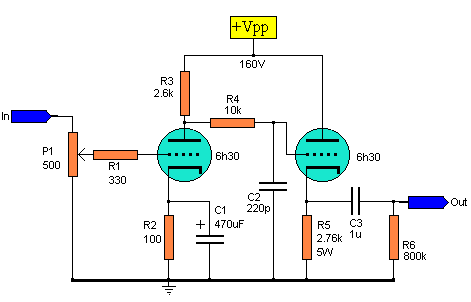
The input Pot must be adjusted according to the DAC output current level . The interstage 1st order low-pass filter removes high frequency noise.
The solution, simple and elegant at the same time, is shown in the following.
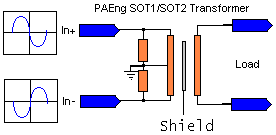
It follows an example with both the solutions for BB's converters.
Network R14-C4 can be removed in the 96..192kHz context.
|
|
Output Spectrum@2.45Vrms

References:
S. Perugini, "A 24-Bit DAC", Glass Audio 6/98
Burr-Brown IC Data Book (Data Conversion Products) 1997
|
SOT3 Type |
SOT3 Type is specifically optimised for use with solid state or vacuum tube amplifiers. At first SOT3 can be used to provide isolation between different amplification stages. Signal to Noise Ratio can be effectively improved by removing ground loops.
In fact, multiple ground points separated by large distance become easily sources of noise. Natural isolation of transformer solve this problem by breaking any loops.
Low level/high impedance circuits are noise sensitive. Balanced transmissions are used to reduce common-mode noise. SOT3 can be used for single-ended to differential conversion and viceversa in pre-amplifiers and amplifiers.

Single ended transmission systems consist of a signal line on which audio signals are sent down and a ground line through which the current returns. A direct results of this is that the ground line forms part of the transmission line: a benefit in some circumstances but not in others.
One of the major benefits, and most obvious, is that a single ended transmission system is the cheapest solution in terms of cabling and circuit complexity.
The main disadvantage of the single ended solution is its poor noise immunity...... because the ground wire forms part of the transmission line, any EMI or shift in the ground potential is detected on the receiver side, thus increasing susceptibility to noise.
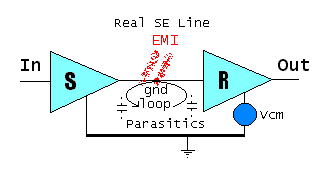
Another common problem is the effect of crosstalk between adjacent signal lines and the coupling into the line of noise from other sources. The line is both inductive and capacitive so will be suspeptible to both electrostatic and magnetic coupling.
Induced noise can be reduced by conventional remedies as lenght limitation and conductor shileding...
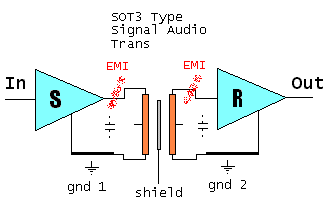
System noise due to voltages generated in the ground path can be reduced by the inherent galvanic isolation of a signal transformer.
Audio signal transformers permit other benefits as a true differential line transmission....
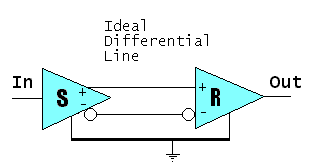
...a differential line involves the use of two signal carrying wires between the source and the receiver, such that the signal current flows in opposite directions in each wire. In this manner at the receiver side the concern is only with the difference in voltage between the two wires therefore DC and noise common mode voltage are in this manner naturally cancelled. In pratice, real differential or balanced lines have solely a finite common mode rejection in wich they can operate.
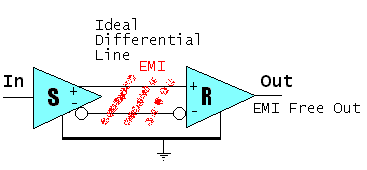
Next figure shows a simple line-guide for dealing shield
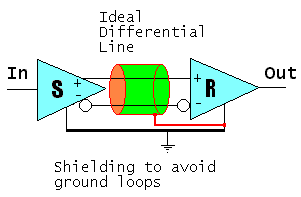
grounding in differential systems. If the shield is grounded at both driver and receiver ends, then a possibile ground loop path exists wich can lead to problem above mentioned. The answer is to ground the shiled only at the receiver end. This ensure that a ground loop current cannot flow. The shield acts as low impedance path to ground for exeternally interfering signals.
SOT3 Type of Signal Audio Transformer thanks to galvanic isolation avoid this problem from the start and its use is recommended both in a true balance environment and as single ende to differential converter (and viceversa).

Another standard application for SOT3 type is as "paraphase" inverter for push-pull vacuum tube amplifiers. Two 180° out-of-phase signals are obtained canonically with active circuitry (i.e. with vacuum tube specific stages). This circuit unfortunately have a lot of problems as impedance mismatch, no uniformity in overall audio range, and so on..... and for the audiophile community also poor sonic performances.
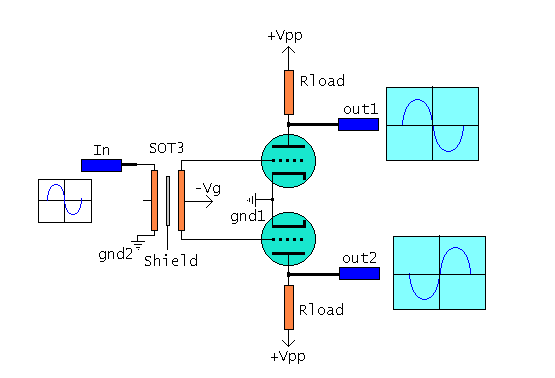
References:
Advanced Linear for Precision Designs of the 90's - Texas Instruments, 1991 Design Seminar.
|
What did you
think of this article? |